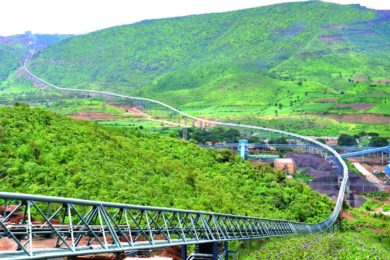 GIW engineering experts travel frequently to mining sites all over the world, including the oil sands mining operations in Alberta, Canada. The oil sands sites present many unique challenges to mining operations, including extreme weather (such as temperatures below -40o F during the winter.) During visits with oil sands customers, GIW observed the pump houses that customers currently have in operation. Based on these observations, GIW noted room for design improvements that would provide better equipment alignment during operation and ease of maintenance during rebuilds. The existing pump houses allow some mobility, but the houses vary in design and quality.
GIW engineering experts travel frequently to mining sites all over the world, including the oil sands mining operations in Alberta, Canada. The oil sands sites present many unique challenges to mining operations, including extreme weather (such as temperatures below -40o F during the winter.) During visits with oil sands customers, GIW observed the pump houses that customers currently have in operation. Based on these observations, GIW noted room for design improvements that would provide better equipment alignment during operation and ease of maintenance during rebuilds. The existing pump houses allow some mobility, but the houses vary in design and quality.
GIW saw this need as an opportunity to provide a better working situation for its pumps and to offer a better solution to its customers. With this in mind, GIW has proposed a portable pump house that is engineered specifically to withstand the conditions in the oil sands mining operations.
GIW’s pump house design is innovative and efficient, designed to reduce labour and maintenance costs and to extend pump life:
- Standardised design
- Plug and play modular design
- One design accommodates multiple size pumps
- Equipped with crane for maintenance
- Requires minimal ground preparation.
GIW designed a modular pump house that has features never provided before in one single package, it says. Most pump houses are not built by pump manufacturers. They are usually built by companies that construct
permanent houses and stick-built mobile houses. The current houses used are not designed with skid stiffness to protect equipment alignment during operational load variations, and pump rebuild work often requires the roof of the house to be removed!
The GIW special pump house team includes GIW project managers, mechanical engineers, an electrical engineer, CAD designers, purchasing agent, documentation specialists and quality control inspectors. The project began with GIW engineers modelling the house in 3D. Then, a finite element analysis was performed to ensure the skid had the correct strength and stiffness for the loads it would be exposed to during transport and operation. From the skid that provides the moveable pump system to the foundation the modular pump house and E-house will sit on, GIW personnel were involved.
The GIW pump house is equipped with climate control that allows the equipment to operate properly in extreme weather conditions. In addition to climate control, this pump house includes an in-house cantilever crane with truck access, which means the roof can remain in place even during pump rebuild work. The combination of climate control and the in-house crane will considerably ease maintenance and rebuild work during extreme weather conditions. The structure meets or exceeds not only OSHA requirements but also all Canadian and US building codes as well.
The house itself is constructed as two modules – one to house the pump (pump house) and one to house the electrical equipment (E-house). It is designed not only to be lifted but also dragged if needed without damaging the house or equipment.
The E-house contains all electrical equipment, keeping it separate from the pump house so as to protect it from the vibrations the pump creates and from the bitumen slurry the pump transports.
The two units (pump house and E-house) can be bolted together during transport. However, once they arrive at the mining site, they will be taken apart. The two houses will sit 150 mm apart, connected only by electrical wiring. This prevents vibrations from being transferred from the pump house module to the electrical components.
GIW engineers worked with a structural engineering firm to design the gravel foundation for the pump house and E-house. For higher pressure applications, additional piers and tie downs are added to carry the additional horizontal forces.
Construction of the pump house began in September 2011 and will continue this fall and winter, with a delivery date of February 2012. The pump house must be delivered during the winter months, when the ground is frozen so that the house weight of some 300,000 kg won’t damage the public roads it travels on.
GIW has contracted with a company that is highly experienced in moving large equipment for the oil sands operations. The E-house will ship intact, but the pump house will ship in pieces from its origination point in South Dakota to Fort McKay, Canada. The houses will be assembled in Fort McKay and then moved to the mine site.








